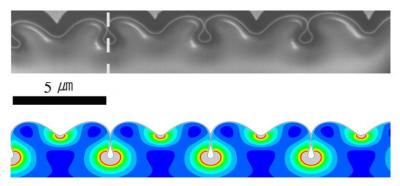Brown University researchers in partnership with Korean scientists have identified unique properties in nanoscale folds and wrinkles.
According to the findings, wrinkles formed on ultrathin films have hidden long waves that can be stretched even when the film is in a compressed state. The researchers have also found that several hundreds of closed nanochannels that resemble ultra-small pipes are created below the surface during the formation of folds on such films.
 Researchers at Brown University and in Korea used focused ion beams to extract a cross-section of compressed gold nanofilm. When tips of regular, neighboring folds touched, nanopipes were created beneath the surface. Credit: Kyung-Suk Kim lab, Brown University
Researchers at Brown University and in Korea used focused ion beams to extract a cross-section of compressed gold nanofilm. When tips of regular, neighboring folds touched, nanopipes were created beneath the surface. Credit: Kyung-Suk Kim lab, Brown University
Wrinkles, which are forerunners of normal folds, are formed when a thin film is clasped on a soft base, and further compression of the sheet will result in the formation of folds due to the tight spacing of wrinkles. Manufacturers show interest on these folds, as they can accommodate large surface area in a limited space.
The researchers placed 20-80 nm thick sheets of gold nanogranular film on a rubbery substrate that is widely utilized in the microelectronics industry. They then compressed the sheet to form wrinkles and studied their properties. In earlier investigations, they observed primary wrinkles having short periodicities, which represent the distance between valleys or peaks of individual wrinkles. Now, they have found another type of wrinkle having a periodicity longer than that of the primary wrinkles, resembling a hidden long wave.
When the gold nanogranular film was compressed, the researchers observed a decrease in the periodicity of the primary wrinkles. However, the hidden long waves or the secondary wrinkles’ periodicity surprisingly lengthened. The researchers discovered even surprising results during the formation of the folds in the nanofilm. On the surface, everything seems to be normal. However, when the researchers measured those folds on their elongated state, their length did not match that of the original film prior to its compressed state. Actually, a part of the original film surface had been modified as nano-size closed channels, which were not discovered in earlier studies that used atomic force microscopy.
This research team used focused ion beams to take out a cross-section of the thin film. It is the first to discover the hidden nanochannels having diameters ranging from 50 to 100 nm. These closed nanochannels can be used as a funnel to deliver drugs or as microscopic hydraulic pump for harvesting energy or cleaning water.